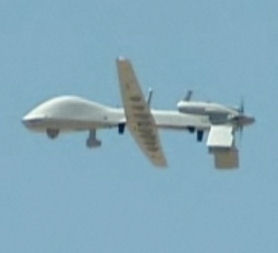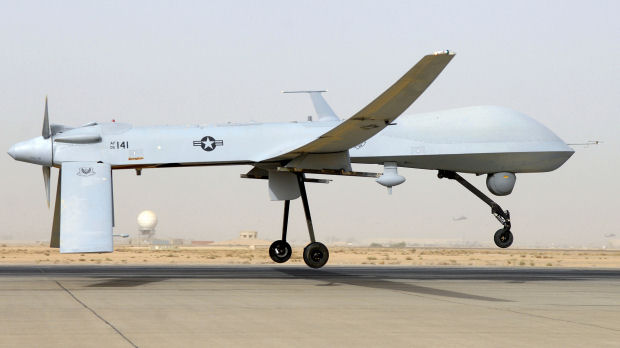CIA Pakistan drone strikes: what the experts say
What is behind the surge in CIA drone strikes in Pakistan over the last two years? Channel 4 News asked a panel US defence analysts and commentators for their views.

The last two years have seen a significant increase in the use of unmanned warplanes, or drones, in Pakistan.
The New America Foundation website estimates this has resulted in between 952 and 1,591 deaths (as of 16 December 2010).
The Central Intelligence Agency refuses to comment on such activity, but it is assumed the attacks are CIA-controlled.
The involvement of the CIA in attacks inside a country with which the United States is not at war prompts a variety of questions.
Channel 4 News put some of those questions to a panel of defence analysts and commentators in the United States.
Channel 4 News special report - interactive map and analysis from Jonathan Rugman: Pakistan drone warfare
There has been a significant increase in CIA drone strikes on Pakistan under Barack Obama. So Obama tells CIA Director Leon Panetta he is authorising a strike. Then what?
Noah Schachtman, Wired.com
I don’t think we know for sure. I’m reasonably sure Obama isn’t signing off on each strike individually.
Peter W Singer, Brookings Institution
That is part of the problem. There doesn’t seem to be a “then what?” part of the plan. The strikes are an effective tactic that have made it harder for the targeted groups to operate in the open, but it’s unclear how it can yield long-term success.
We are certainly killing some bad people, but the pipeline of bad people (the groups’ recruiting and propaganda networks) doesn’t seem to be harmed. It’s a bit like that old carnival game of “whack a mole”.
Bill Roggio, editor, The Long War Journal
My understanding is that the chain of command has been devolved to the CIA director of operations. He would be the one managing the strikes.
They’re obviously pulling in intelligence from other US assets such as NSA (National Security Agency) and the military. There’s a coordination of intelligence gathering.
The strikes are an effective tactic, but it’s unclear how it can yield long-term success. Peter W Singer, Brookings Institution
This really started up under President Bush in the summer of 2008. Before, my understanding is that it had to go up to the office of the president to approve the strikes. Now, with their increased frequency, my understanding is that that’s gone away. It’s become part of the battle rhythm.
The CIA have got a fleet of planes. I don’t know where they’re running from, and I don’t believe they’re connected to the operations in Creech (Air Force Base, where the US controls drone activity in Afghanistan). I’ve heard rumours there are civilian pilots and air force pilots that have been flying them.
John Pike, director, GlobalSecurity.org
The whole idea of Obama is to wind down Iraq and double-down on Afghanistan. The targeted drone killings are a smaller element of a larger agenda.
A lot of the people who live there think the Afghanistan-Pakistan divide is artificial. The Pakistan government effectively acknowledged this by not having any presence in the federally administered tribal areas (FATA). So you’ve got to do something about it.
The Taliban have a base of operations in the FATA – and a fundamental premise of counter-insurgency warfare is that you cannot allow your enemy a sanctuary.
Are the names available of anyone, either in the Department of Defense or the CIA, involved in the commissioning and deployment of drones?
Noah Shachtman
This is the curious part. The US has declared that Afghanistan and Pakistan are two segments of a single conflict.
But in one part of the conflict the drones strikes are very open. You can go out to Las Vegas and interview the head of the squadron piloting the drones and talk to the pilots.
You can go to Kandahar and visit the guys who maintain the drones on the ground in Afghanistan. You can meet with the intelligence analysts who process the video and look for evidence of insurgents within the video.
But with the Pakistan strikes none of that is the case. You don’t know who these people are. The extent to which contractors are involved is shrouded in mystery. It’s very much an opaque operation.
With the Pakistan strikes, you don’t know who these people are. It’s very much an opaque operation. Noah Shachtman, Wired.com
Confusing matters further is that sometimes those Afghan drone operations go over the border into Pakistan. You’re allowed to chase insurgent suspects into Pakistan – and US drones do that sometimes.
Peter W Singer
You need to distinguish between battlefield use of the systems by the Department of Defense (and RAF), which is overt and admitted to in places like Afghanistan, from the “covert” use of them across the border, which is fairly well known to be by the CIA but not openly admitted to.
Bill Roggio
The CIA has its own budget, with portions of it that are black. The National Security Agency has that as well. They have their own budget that just won’t see the light of day. They’ll purchase (the drones) through normal channels we just don’t know about.

Where are the CIA drones over Pakistan controlled from? And who controls them?
Noah Shachtman
Published reports say the drones focused on Pakistan are largely controlled out of Virginia – but I don’t have any independent information on that.
There were for a long time drones based inside of Pakistan, but then the Pakistan media found one of those bases on Google Earth, and so the rumour is that they’ve been moved to the other side of the border.
Peter W Singer
You have people outside the military chain of command, making decisions about the use of force in a way that would have previously been done inside the military.
The easiest part of this whole thing to discover is the results. The reason we see what’s happening in north western Pakistan is the results. Bill Roggio, The Long War Journal
The concern here is, not only are the legal questions thus more thorny (a military officer is accountable to military law; by comparison, civilian law is not well set up for civilians engaged in war), but also an experience and skillset mismatch.
The head of the CIA is a political appointee, a former congressman from California, not an air force general who has spent his career planning for air war.
Bill Roggio
We don’t know the specifics of who’s flying and maintaining them. There was a report that Blackwater was doing maintenance on the drones. I would guess what the USAF is doing, which is flying them from the United States.
What’s funny is, the easiest part of this whole thing to discover is the results of it. I don’t have the results of Afghanistan Predator strikes – that’s because more of them happen and you don’t see the report. The reason we see what’s happening in north western Pakistan is the results.
Are drones being used in more populated areas nowadays because technology is getting more accurate, as the military claims? And who are the major players in the UAV field?
Noah Shachtman
First, the drone campaign is much more aggressive. Number two, presumably cooperation with Pakistan intelligence has got better and the CIA has developed more assets there.
And thirdly, according to published reports, the CIA is using smaller weaponry on the drones, so the chances of collateral damage have been reduced.
As far as major players are concern, with the drones it’s General Atomics.
Peter W Singer
It’s a booming industry now, with such systems being worked on in 44 countries. General Atomics and Northrop Grumman are just two of many, many.
In Pakistan we’re going to kill people that happen to be in the wrong place at the wrong time. That’s how we know it’s war. John Pike, GlobalSecurity.org
Indeed, there is not a single aerospace company in the west now that has a manned combat aircraft in the research and development stage. All of them being presently researched for the next generation are unmanned.
John Pike
Regarding accuracy, it is unavoidably the case that in these operations against the enemy in Pakistan, we’re going to kill people that happen to be in the wrong place at the wrong time. That’s how we know that it is war.
It is a challenge in a war of this sort that the enemy is not in uniform. So the traditional notion that we can shoot the people wearing the wrong uniform and then send their effects to the wives and kids back home – we can’t do that.
If, after half a century, the US Department of Defense cannot tell you whether the Korea body count was 30,000 or 50,000, then how can you expect any precision in matters such as these?
-
Latest news
-
Yungblud launches his own affordable music festival5m

-
Why these Americans want to quit their state9m

-
Company behind infected water outbreak are ‘incompetent’ says local MP5m

-
Israeli forces push deeper into Northern and Southern Gaza4m

-
India’s ‘YouTube election’: Influencers enlisted to mobilise youth vote6m

-




